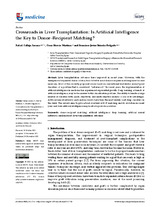Mostrar el registro sencillo del ítem
Crossroads in Liver Transplantation: Is Artificial Intelligence the Key to Donor–Recipient Matching?
| dc.contributor.author | Calleja Lozano, Rafael | |
| dc.contributor.author | Hervás-Martínez, César | |
| dc.contributor.author | Briceño Delgado, Francisco Javier | |
| dc.date.accessioned | 2022-11-30T10:20:18Z | |
| dc.date.available | 2022-11-30T10:20:18Z | |
| dc.date.issued | 2022 | |
| dc.identifier.uri | http://hdl.handle.net/10396/24373 | |
| dc.description.abstract | Liver transplantation outcomes have improved in recent years. However, with the emergence of expanded donor criteria, tools to better assist donor–recipient matching have become necessary. Most of the currently proposed scores based on conventional biostatistics are not good classifiers of a problem that is considered “unbalanced.” In recent years, the implementation of artificial intelligence in medicine has experienced exponential growth. Deep learning, a branch of artificial intelligence, may be the answer to this classification problem. The ability to handle a large number of variables with speed, objectivity, and multi-objective analysis is one of its advantages. Artificial neural networks and random forests have been the most widely used deep classifiers in this field. This review aims to give a brief overview of D–R matching and its evolution in recent years and how artificial intelligence may be able to provide a solution. | es_ES |
| dc.format.mimetype | application/pdf | es_ES |
| dc.language.iso | eng | es_ES |
| dc.publisher | MDPI | es_ES |
| dc.rights | https://creativecommons.org/licenses/by/4.0/ | es_ES |
| dc.source | Medicina, 58(12), 1743 (2022) | es_ES |
| dc.subject | Donor–recipient matching | es_ES |
| dc.subject | Artificial intelligence | es_ES |
| dc.subject | Deep learning | es_ES |
| dc.subject | Artificial neural networks | es_ES |
| dc.subject | Random forest | es_ES |
| dc.subject | Liver transplantation outcomes | es_ES |
| dc.title | Crossroads in Liver Transplantation: Is Artificial Intelligence the Key to Donor–Recipient Matching? | es_ES |
| dc.type | info:eu-repo/semantics/article | es_ES |
| dc.relation.publisherversion | https://doi.org/10.3390/medicina58121743 | es_ES |
| dc.rights.accessRights | info:eu-repo/semantics/openAccess | es_ES |

